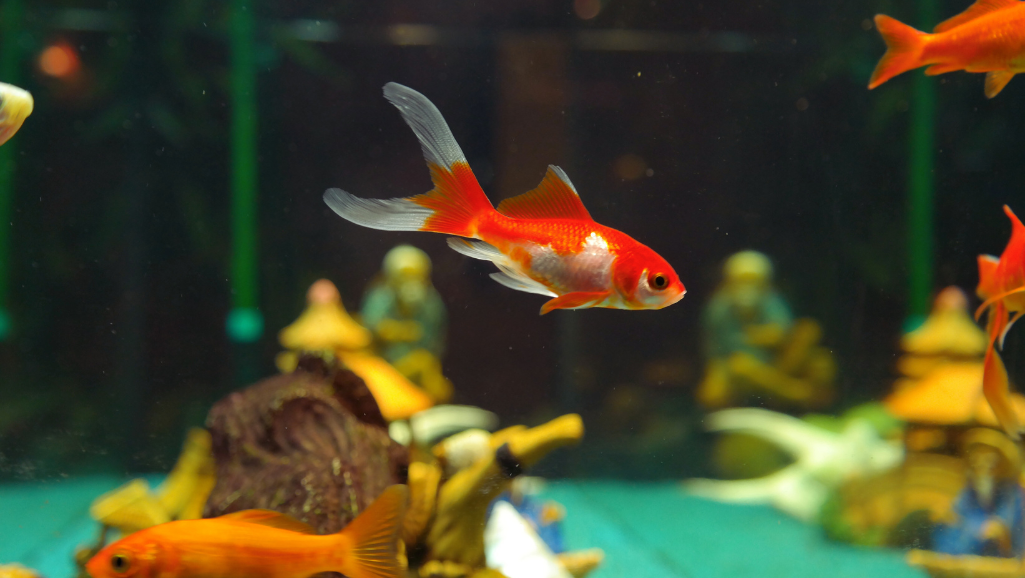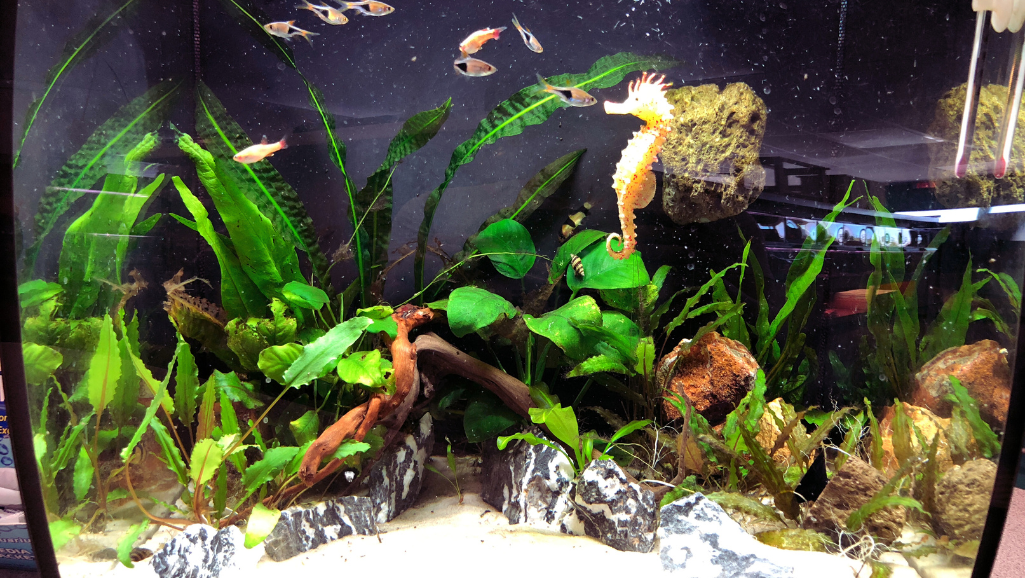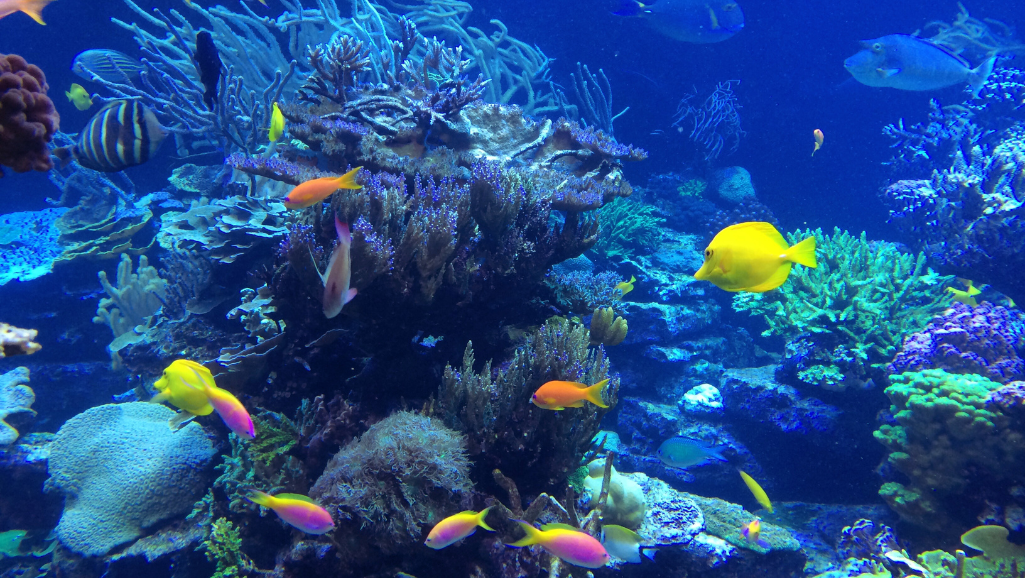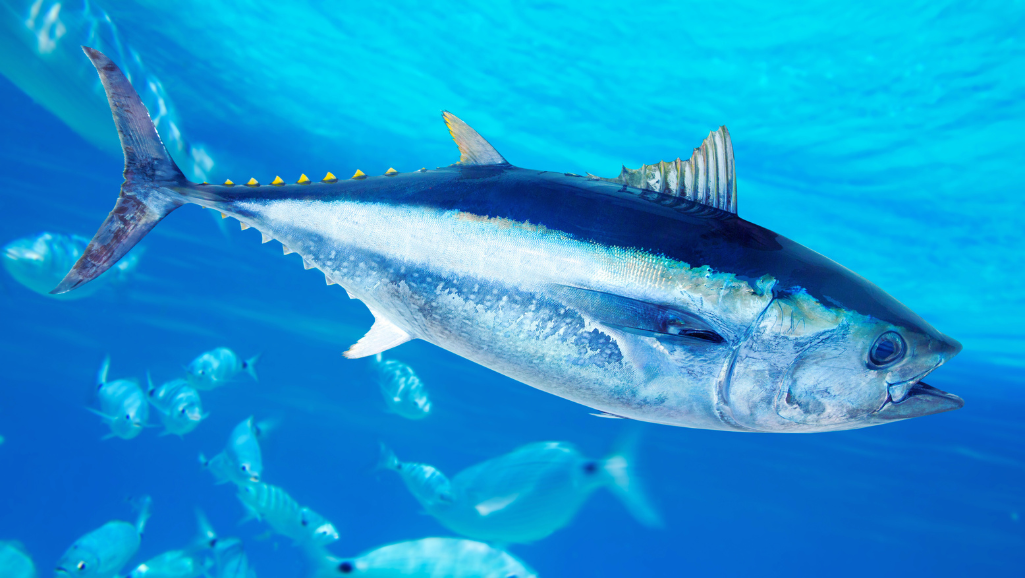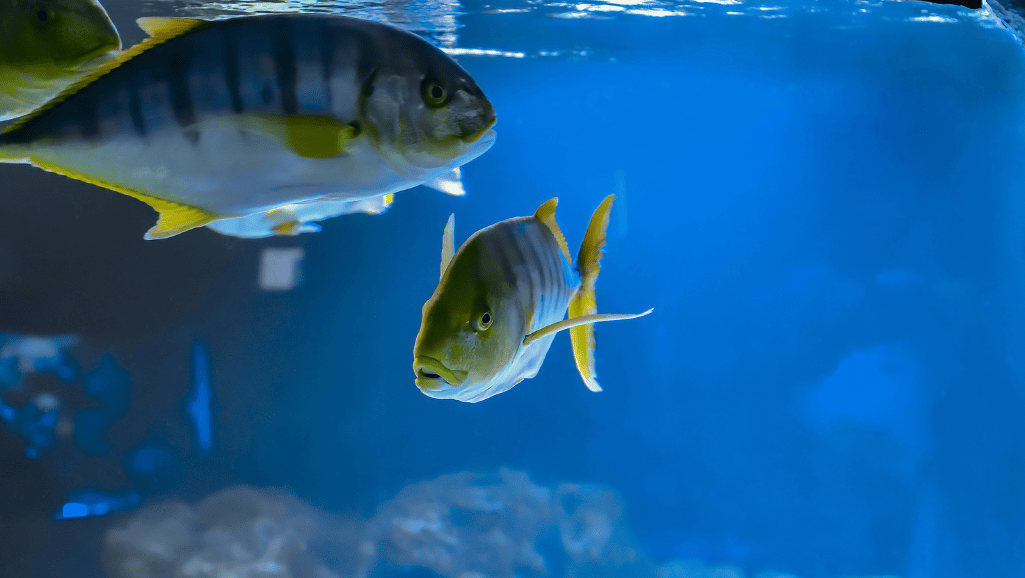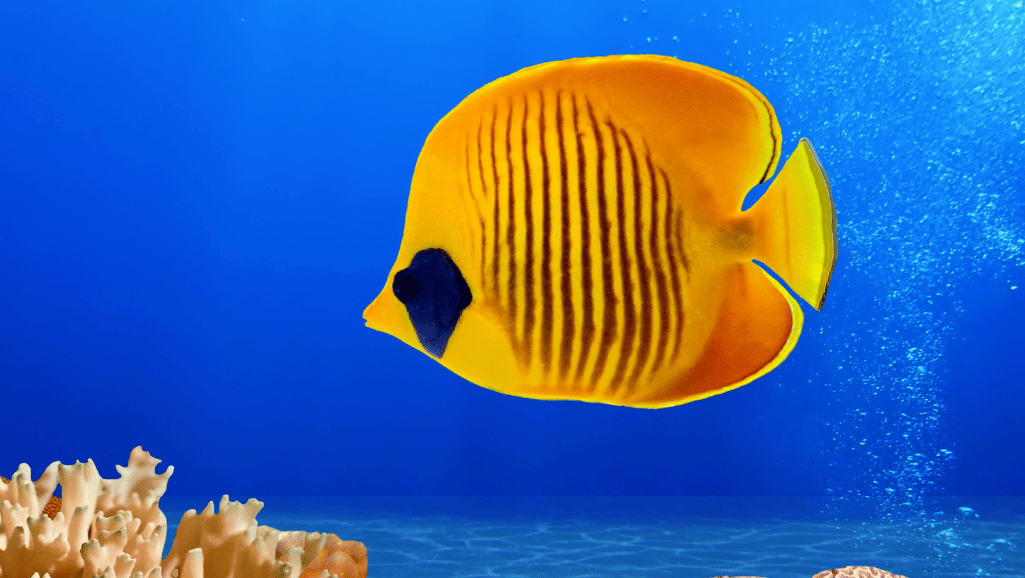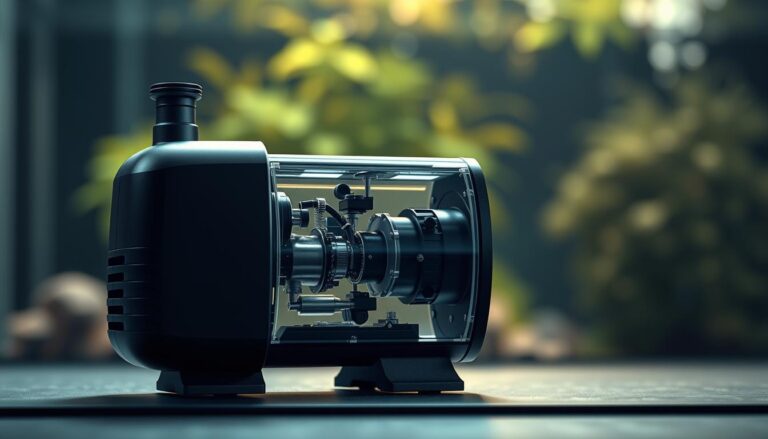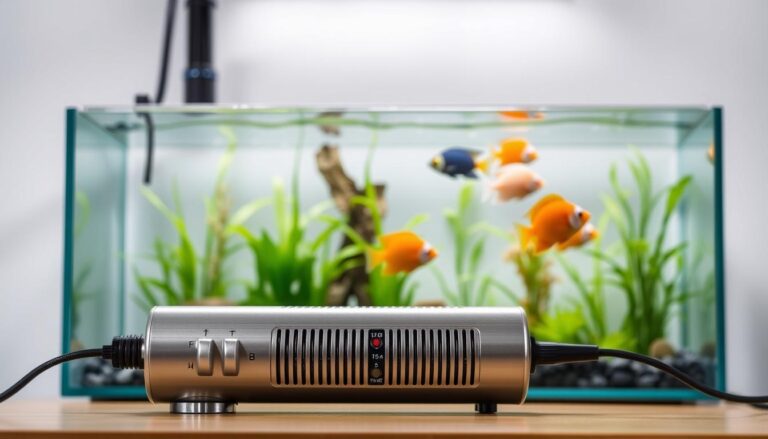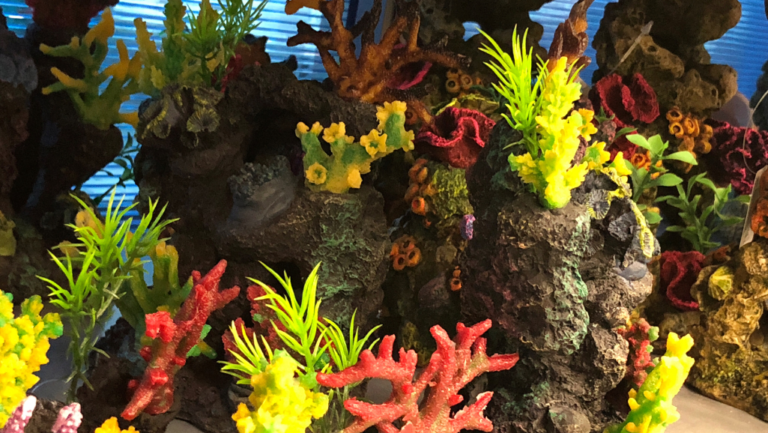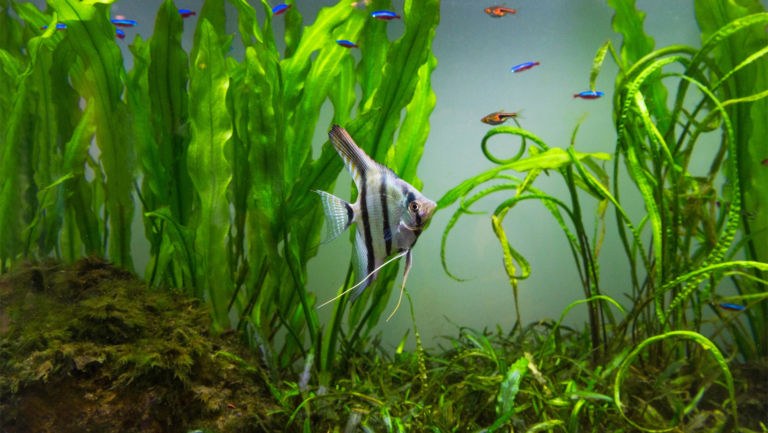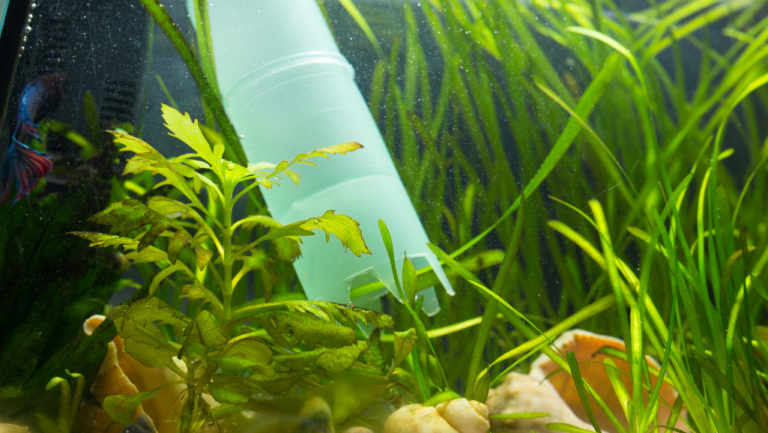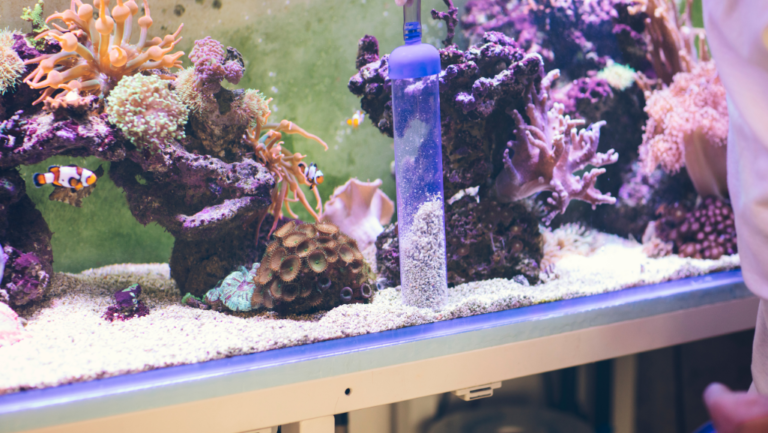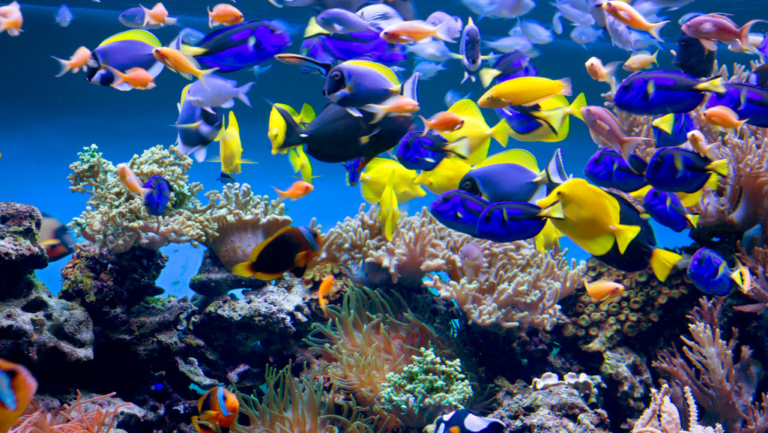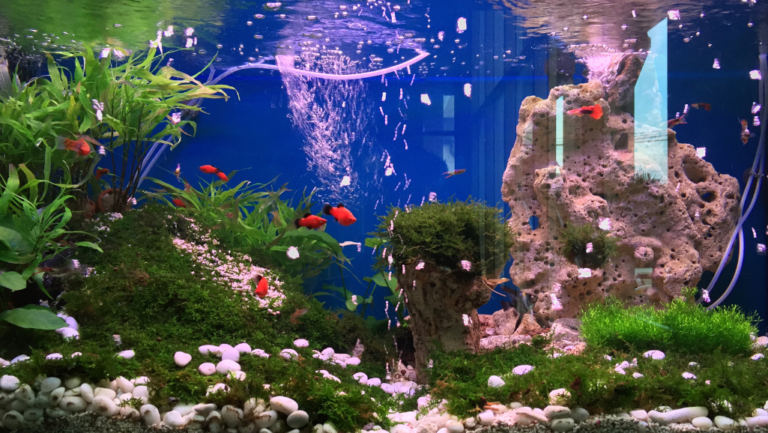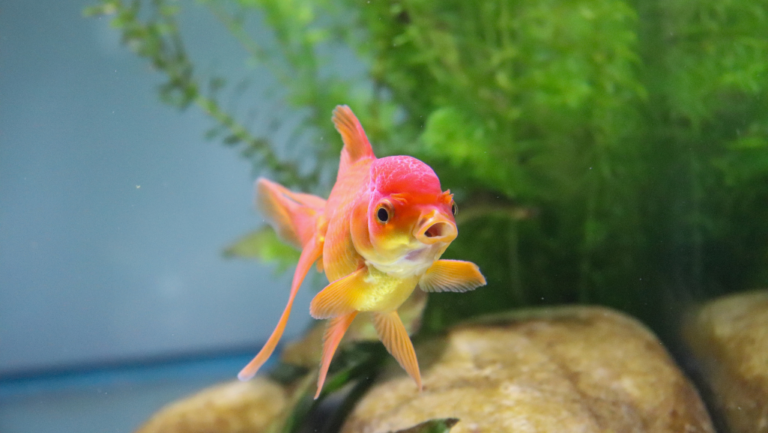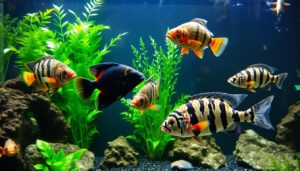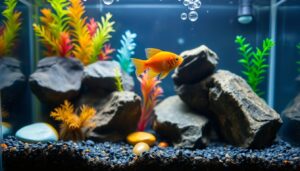Creating a peaceful underwater world begins with knowing about aquarium fish compatibility. A good fish compatibility guide is key for aquarium lovers, helping them choose appropriate fish to avoid fights and keep the tank calm, which is vital for your fish’s health.
While there are some rules, each fish’s special needs matter. This includes things like water type and how they act. Use a fish tank compatibility chart to pick the right fish friends. This way, your tank can be a place of peace and friendship.
Key Takeaways
Use a detailed aquarium fish compatibility chart to keep the tank peaceful.
Think about fish size and how they act to create a calm space. Some fish, like Betta fish, need extra care.
Consider the adult size fish when planning your tank to ensure adequate space and avoid overcrowding.
Make sure all fish get the right food and water conditions for their health.
Be careful when adding new fish. Use a quarantine period and slowly introduce them to the tank.
Keep the water clean and watch your fish to prevent sickness.
Remember, fish have their own likes and dislikes, leading to unique tank communities.
Understanding Aquarium Fish Compatibility
https://www.youtube.com/watch?v=4Bsk0tVMoSM
Knowing about aquarium fish compatibility is key for a calm underwater world. By looking into tank mate compatibility, we can predict if different fish species will get along. Things like fish personality, size, water needs, and how they mark their territory are important.
Some fish can get aggressive as they grow older. This shows why having a current aquarium fish compatibility list is vital. It groups fish that can live together peacefully. This list helps in creating a tank full of different fish that get along.
Minimum Tank Sizes: It’s important to give each fish enough room. For example, a Betta fish needs a 5-gallon tank. Corydoras need a tank of at least 20 gallons.
Temperature and Group Sizes: The right temperature is crucial, like keeping Betta fish in 76 to 82°F water. Also, some compatible fish species, like Neon tetras, do best in groups of at least six.
Water Quality: Regular water changes, like 10-20% weekly, are important. They help keep the water clean and healthy. Keeping nitrate levels below 40 ppm is also key for a healthy tank.
By carefully following these tips, you can make your aquarium beautiful and healthy. Understanding tank mate compatibility is not just about looks. It’s about creating a happy and thriving underwater world.
Remember, you might need to make changes over time. Things like new fish, plants, or even breeding can change the tank. This shows the ongoing effort needed to keep aquarium fish compatibility working well.
Creating a Harmonious Community Tank
Creating a balanced ecosystem is key for a community fish tank. Choosing the best tank mates for aquarium fish helps make a peaceful place. This environment supports the health of all fish in the tank.
Importance of a Balanced Ecosystem
Keeping water parameters like pH, temperature, and hardness right is crucial. In a balanced ecosystem, the presence of dominant fish can influence the behavior of other tank inhabitants. Regular checks and adjustments keep the tank perfect for each fish. Using tools from AquaJoy’s aquarium cleaning tools helps keep these conditions stable.
Think of the tank as a system where each part is important. Checking water quality often and using resources like the Freshwater Fish Compatibility Chart helps. This keeps the tank peaceful and reduces stress and aggression.
Selecting Compatible Fish Species
Choosing fish for a community tank needs thought about their biology and behavior. Aggressive or territorial fish can upset the tank’s peace. Local fish stores, books, and online forums offer great advice on fish species compatibility.
Planning the tank’s population is also key. For example, a 20-gallon tank can have Neon Tetras, Harlequin Rasboras, Corydoras Catfish, and a Dwarf Gourami. These fish are known for getting along well. This careful planning ensures everyone has enough space and resources. If any fish exhibit aggressive tendencies, it may be necessary to separate fish to maintain a harmonious environment.
Introducing new fish to the tank must be done carefully. Quarantining new fish for 2-4 weeks stops diseases from spreading. This keeps the whole tank healthy.
Don’t overcrowd the tank. The “one inch of fish per gallon” rule helps avoid this. Too many fish can lead to stress and health problems.
Managing a community aquarium well means always watching and adjusting. Talking to experts and being careful ensures the tank stays balanced. This lets all the fish thrive together.
The Aquarium Fish Compatibility Chart Explained
For anyone starting with aquariums, knowing about tropical fish compatibility is key. A community fish compatibility chart is a must-have. It helps you pick fish that get along well.
Wider aquariums benefit active fish by providing ample swimming space, fostering better social interactions.
When you’re setting up a fish tank community guide, these charts are super helpful. They show which fish can live together peacefully and which might cause trouble. Following these charts helps avoid stress, fights, and even death in your tank.
Fish Category | Compatibility Indicator | Common Characteristics |
|---|---|---|
African Cichlids | N | Aggressive, territorial, high activity levels |
Top Freshwater Goby Species | Y | Peaceful, requires specific water conditions |
Freshwater Shrimps | C | Peaceful, can coexist if predators are absent |
Community Peaceful Fish | Y | Similar temperaments, diet, and environmental needs |
Freshwater Tank Bullies | N | High aggression, prone to dominate smaller or timid fish |
Each entry in the community fish compatibility chart looks at important factors. These include water temperature, gender, diet, size, activity level, and pH levels. For example, aggressive species like some Cichlids are marked as ‘N’ for incompatible. This means they should be kept with other aggressive or larger fish.
When setting up your tank, remember the rule of about one inch of fish per gallon of water. This rule helps avoid overcrowding. Overcrowding can lead to fights and health problems. Freshwater fish are generally easier to mix and match because they prefer a wide range of water conditions.
Understanding and using a fish compatibility chart is more than just avoiding fights. It’s about creating a space where all fish can live well together. Each fish adds to the balance and beauty of your tank. Always check a recent tropical fish compatibility chart when setting up or changing your tank. This ensures a peaceful and thriving aquatic world.
Categories of Compatibility in Fish Tank Mates
Knowing which fish go well together in an aquarium is key. This guide explores the different types of compatibility. It helps aquarists choose the right tank mates. Rearranging décor can help reduce aggression when introducing new fish by breaking up territories held by established fish.
Compatible Fish Species
Compatible fish species live peacefully together. Aquarists aim to create a calm environment. This way, all fish stay healthy and colorful.
The fish tank mates list helps by grouping fish into categories. These categories are “Compatible,” “Usually Compatible,” or “Not Compatible.” This makes choosing tank mates easier and keeps the aquarium peaceful.
For example, Tetras and Danios are great for schools. They are calm when in groups. It’s best to get them in groups of six or more to keep them happy.
Common Tank Mates Issues
But, not all fish get along. Territorial disputes and food competition are common problems. Some fish may seem fine at first but become aggressive as they grow.
Cichlids, for instance, defend their territories. This can cause fights in small tanks. It’s important to plan the tank’s layout to avoid these issues. Smaller or submissive fish can be subjected to harassment from more dominant individuals, necessitating careful monitoring.
Some fish, like Catfish and Arowanas, might eat smaller fish. So, it’s crucial to think about size and predatory nature when choosing fish. This helps keep the tank balanced.
Adding decorations like rocks and plants can help. They create territories and hiding spots. Keeping the water clean and feeding fish right can also reduce fights.
Creating a peaceful aquarium is more than just following a compatibility chart. It requires watching and adjusting to the fish’s behavior. Aquariums are always changing, so it’s important to stay alert and make changes as needed.
Good strategies include the right gender ratio for live-bearing fish and not overstocking. Regularly checking for stress or aggression signs is also key. With these tips and a reliable fish tank mates list, you can create a calm and stable aquarium.
Tropical Fish Compatibility: Best Practices
Starting a tropical aquarium means knowing how fish get along. A tropical fish compatibility chart is key to keeping your tank peaceful. Here are some tips to follow:
- Research thoroughly: Learn about each fish’s needs like space, food, water, and mood. The tropical fish compatibility guide helps pick the right fish friends.
- Assess size and temperament: Fish that are similar in size and calm usually get along well. Don’t mix small, calm fish with big, bossy ones.
- Environment setting: Make sure your tank meets all fish needs. Add hiding spots and terrain that feels like home to them.
- Conditioning and quarantine: Quarantine new fish to stop disease and check their health and mood.
- Progressive introduction: Add new fish slowly and watch how they get along. You might need to make changes if they don’t get along.
Here’s a table of fish that go well together in a tank, especially with seahorses. It shows who’s good to have around and who’s not:
| Compatible Tankmates | Species to Avoid |
|---|---|
| Percula Clownfish (Amphiprion percula) | Predatory Fish (larger groupers, morays) |
| False Percula Clownfish (A. ocellaris) | Triggerfish |
| Firefish Goby, Neon Goby | Angelfish, Puffers |
| Royal Grammas, Blackcap Basslets | Cowfish, Lionfish |
| Green Chromis, Mandarin Gobies | Large predatory Starfish (e.g., chocolate chip starfish) |
Remember, the tropical fish compatibility chart is just a guide. Fish can be different. But following these tips will help your tank thrive.
Freshwater vs. Saltwater Fish Compatibility
Starting a tropical aquarium means knowing how fish get along. A tropical fish compatibility chart is key to keeping your tank peaceful. Here are some tips to follow:
Research thoroughly: Learn about each fish’s needs like space, food, water, and mood. The tropical fish compatibility guide helps pick the right fish friends.
Assess size and temperament: Fish that are similar in size and calm usually get along well. Don’t mix small, calm fish with big, bossy ones.
Environment setting: Make sure your tank meets all fish needs. Add hiding spots and terrain that feels like home to them.
Use decorations like rocks and plants to help other territorial fish establish their own spaces and reduce conflicts.
Conditioning and quarantine: Quarantine new fish to stop disease and check their health and mood.
Progressive introduction: Add new fish slowly and watch how they get along. You might need to make changes if they don’t get along.
Here’s a table of fish that go well together in a tank, especially with seahorses. It shows who’s good to have around and who’s not:
Compatible Tankmates | Species to Avoid |
|---|---|
Percula Clownfish (Amphiprion percula) | Predatory Fish (larger groupers, morays) |
False Percula Clownfish (A. ocellaris) | Triggerfish |
Firefish Goby, Neon Goby | Angelfish, Puffers |
Royal Grammas, Blackcap Basslets | Cowfish, Lionfish |
Green Chromis, Mandarin Gobies | Large predatory Starfish (e.g., chocolate chip starfish) |
Remember, the tropical fish compatibility chart is just a guide. Fish can be different. But following these tips will help your tank thrive.
Freshwater vs. Saltwater Fish Compatibility
Starting an aquarium means knowing the big differences between saltwater and freshwater. Whether you’re making a marine fish tank chart or looking at a freshwater list, it’s all about matching fish to their needs. This includes their environment and how they behave.
Differences in Water Parameters
The main difference between saltwater and freshwater fish is the water chemistry. Saltwater tanks need exact salt levels for marine life to stay healthy. Freshwater fish, however, can live in a variety of pH levels and hardness.
Knowing these details is key to creating a peaceful underwater world.
Popular Choices for Freshwater and Saltwater Tanks
Choosing the right fish is crucial for both saltwater and freshwater tanks. For peaceful saltwater tanks, fish like green chromis and clownfish work well. They get along with other marine life.
Freshwater tanks can have friendly fish like tetras and guppies. They are easy to care for and peaceful. Certain aggressive species, including knife fish, require large aquariums with adequate cover and are better kept alone or with non-similar tank mates.
In specialized tanks, like predator ones, you might have saltwater fish like puffers and lionfish. It’s important to think about their natural behaviors and how they eat. Fish like groupers and anglers eat prey that fits in their mouths.
For better compatibility, add more aggressive marine fish last to set a hierarchy. Also, put fish in pairs or odd numbers to stop bullying. This careful planning is key to using a marine fish tank chart well.
Creating a thriving aquarium starts with understanding the differences and how fish interact. By choosing the right fish and managing the tank well, you can have a lively, healthy underwater world.
Aquarium Fish Compatibility List: A Guide to Tank Harmony
Starting a peaceful aquarium needs a fish tank compatibility guide. This guide is key for anyone wanting a lively community tank. It’s vital to pick compatible aquarium fish species for your pets’ health.
Understanding each fish’s natural behavior and needs is crucial. For example, Neon Tetras look best in groups of six or more. This is true for many species, like Cory Cats, which live in large groups in the wild. Knowing this helps create a natural, comfortable home for them.
Smaller predators like leaf fish also play a crucial role in the ecosystem, hunting for food without being inherently aggressive.
It’s also important to know about fish sizes and growth. Bristlenose Plecos can grow up to 4-5 inches, while Oto Cats stay small. Their size affects where they should be placed in the tank to avoid stress.
Geographic compatibility is another factor in ideal fish combinations for your tank. Fish from the same region, like South America, prefer similar water and food. For example, South American Tetras and Corydoras catfish do well together because they like soft, acidic water.
Fish Type | Group Size | Region | Compatibility Note |
|---|---|---|---|
Neon Tetras | 6+ | South America | Best in schools, vibrant colors in groups |
Cory Cats | 6+ | South America | Prefer soft, acidic water, peaceful |
Oto Cats | 6+ | South America | Small size, need groups for comfort |
Platies | Flexible | Central America | Known as ‘water puppies’, active and hardy |
Choosing the right compatible aquarium fish species keeps your tank peaceful and beautiful. By using this fish tank compatibility guide, you can create a thriving, balanced aquarium.
Compatible Aquarium Fish Species for Beginners
Starting your first aquarium means picking the appropriate fish that live well together. It’s important to choose species that live well together. This ensures a peaceful tank. For beginners, getting advice from aquatic experts can be very helpful.
Low Maintenance and Hardy Fish Selection
Beginners should focus on easy-to-care-for fish. The Aquarium Industries Freshwater Fish Compatibility Chart helps a lot. It shows which fish can live together peacefully.
For example, fish marked with a “Y” are good choices. They won’t fight with each other. It’s also important to check the water quality and use a test kit.
Building Your First Community Aquarium
Setting up your first community aquarium is exciting. It’s more than just picking fish. You need to understand how they live together.
Try rearranging decorations and adding hiding spots. This helps prevent fights. Also, group schooling fish like Tetras or Danios. They are less likely to be aggressive.
To create a thriving community, pick fish that get along. For example, Apistogramma Dwarf Cichlid with Green Neon Tetra or African Cichlids with Synodontis Catfish are good choices. They make your aquarium balanced and lively.
In summary, picking the right compatible aquarium fish and managing your tank well are key. Using guides and charts helps you understand better. This ensures your fish live happily and healthily.
Best Fish Combinations for Aquarium Peace
Creating a peaceful aquarium is more than just making it look good. It’s about choosing the right fish to live together. This keeps each fish healthy and helps them live in harmony.
Peaceful Fish Tank Mates
Peaceful reef tanks have fish that get along well. Green chromis, clownfish, and gobies are good choices because they’re calm. They also get along with other fish in the tank.
Smaller fish like neon tetras, Cory Cats, and dwarf gouramis are also great. They don’t start fights and add color and movement to the tank.
When setting up your tank, follow some rules. Quarantine new fish first. Then, add the more aggressive ones last. This keeps the tank peaceful for everyone.
Creating a Non-Aggressive Aquascape
To keep your tank calm, avoid fights. Change the layout and move rocks around. This helps fish not fight over territory.
Make sure all fish are well-fed. This stops them from fighting over food. Watching your tank and making changes helps keep it peaceful.
Choosing the right fish and watching your tank carefully is key. This way, you can keep your aquarium calm and healthy. It looks great and keeps your fish happy.
Avoiding Aggression: Tips for Introducing New Territorial Fish Tank Mates
Creating a peaceful aquarium environment when mixing fish species in an aquarium needs careful planning. Specific steps can help reduce stress and aggression. This ensures a harmonious habitat for your aquatic pets. One key fish tank community recommendation is the careful introduction of new fish to the existing community.
Rearranging the tank’s decorations is a crucial first step. This disrupts established territories, reducing initial aggression among fish. Adding new hiding spots provides safe havens for newcomers, helping them avoid bullying from established residents.
Timing for adding new fish: Wait about 2 weeks after introducing a new fish to your tank. This allows newcomers to adjust and shows if they carry any diseases.
Acclimatization duration: Gradually acclimate new fish, ideally over 20 minutes using the floating method, to match the tank’s water temperature and chemistry.
Incremental fish introduction: Introduce new fish in stages rather than all at once. This avoids overwhelming the existing ecosystem and causes less stress on both old and new inhabitants.
Ensuring compatibility is another critical factor in maintaining a best community fish for aquarium setup. Studies show that fish like the African Red-Eyed Tetra and Zebra Loach are generally peaceful. They can coexist well with other community fish species.
Moreover, monitoring fish behavior is essential to detect any signs of aggression early. If aggressive behavior is noted, using tank dividers or temporarily relocating aggressive fish can prevent harm. This contributes to an overall best community fish for aquarium environment.
The overall size and layout of your aquarium also play significant roles in species coexistence. Larger tanks provide more space for territories and reduce competition. This effectively lowers the chances for aggressive encounters.
By following these guidelines and continuously monitoring the tank’s dynamics, you can successfully maintain a balanced, peaceful aquarium. Multiple species can thrive together. For more detailed guides on fish compatibility and stress management, explore additional recommendations here.
Conclusion
Creating an ideal fish community tank requires knowledge and care. We’ve learned that starting with the right tank size, temperature, and maintenance is key. A tank size of 5 to 20 gallons is good for beginners, and keeping the water between 64°F and 82°F is crucial for fish health.
Keeping the water clean is essential, with weekly changes of 10-20%. It’s important to choose fish that get along well to avoid stress and fights. A good fish species compatibility chart is a must for a peaceful tank.
When picking fish for a peaceful tank, think about pairs like angelfish and Black Skirt Tetra. Marbled Hatchetfish and Bristlenose Pleco are also good choices. Pencilfish and Corydoras Catfish live in different parts of the tank, and Bolivian Rams are strong and peaceful.
Choosing the right fish is as important as setting up the tank. Avoiding aggressive fish like Tiger barbs is key. By doing this, we create a peaceful and balanced underwater world.
FAQ
What is an aquarium fish compatibility chart?
An aquarium fish compatibility chart helps you pick fish that get along in a community tank. It sorts fish by their behavior, size, and water needs. This makes sure they live well together.
Why is understanding fish compatibility important?
Knowing which fish get along is key to a peaceful tank. It stops fights, stress, and fish loss. Happy fish mean a healthy tank for everyone.
How do I create a balanced ecosystem in my community tank?
Pick fish that match in behavior and needs. Add plants, driftwood, and rocks for hiding spots. This helps fish have their own space and reduces fights.
Are fish compatibility charts always accurate?
Fish compatibility charts are a good start, but not perfect. Each fish is unique. Watch your fish closely and be ready to make changes.
What are common issues with selecting tank mates?
Issues like aggression and food fights can happen. Charts help spot these problems, especially with growing fish.
How is tropical fish compatibility different from freshwater or saltwater fish compatibility?
Tropical fish need to match in temperature and behavior. Freshwater and saltwater fish also need to match in water conditions. Each habitat has its own needs.
What fish make good choices for beginners?
Beginners should pick easy, hardy fish. These are less likely to cause trouble and are simple to care for.
How can you create a non-aggressive aquascape?
Choose peaceful fish and give them lots of space. Add hiding spots and keep the tank from getting too crowded. This prevents stress and fights.
What should I do if there’s aggression in my fish tank after introducing new tank mates?
If fights start, try rearranging the tank and adding hiding spots. Make sure all fish have enough food. If problems persist, move the aggressive fish to another tank.
What are some best practices for tropical fish compatibility?
Research fish before buying, watch their behavior, and use a tropical fish compatibility chart. This helps you choose the right tank mates.
